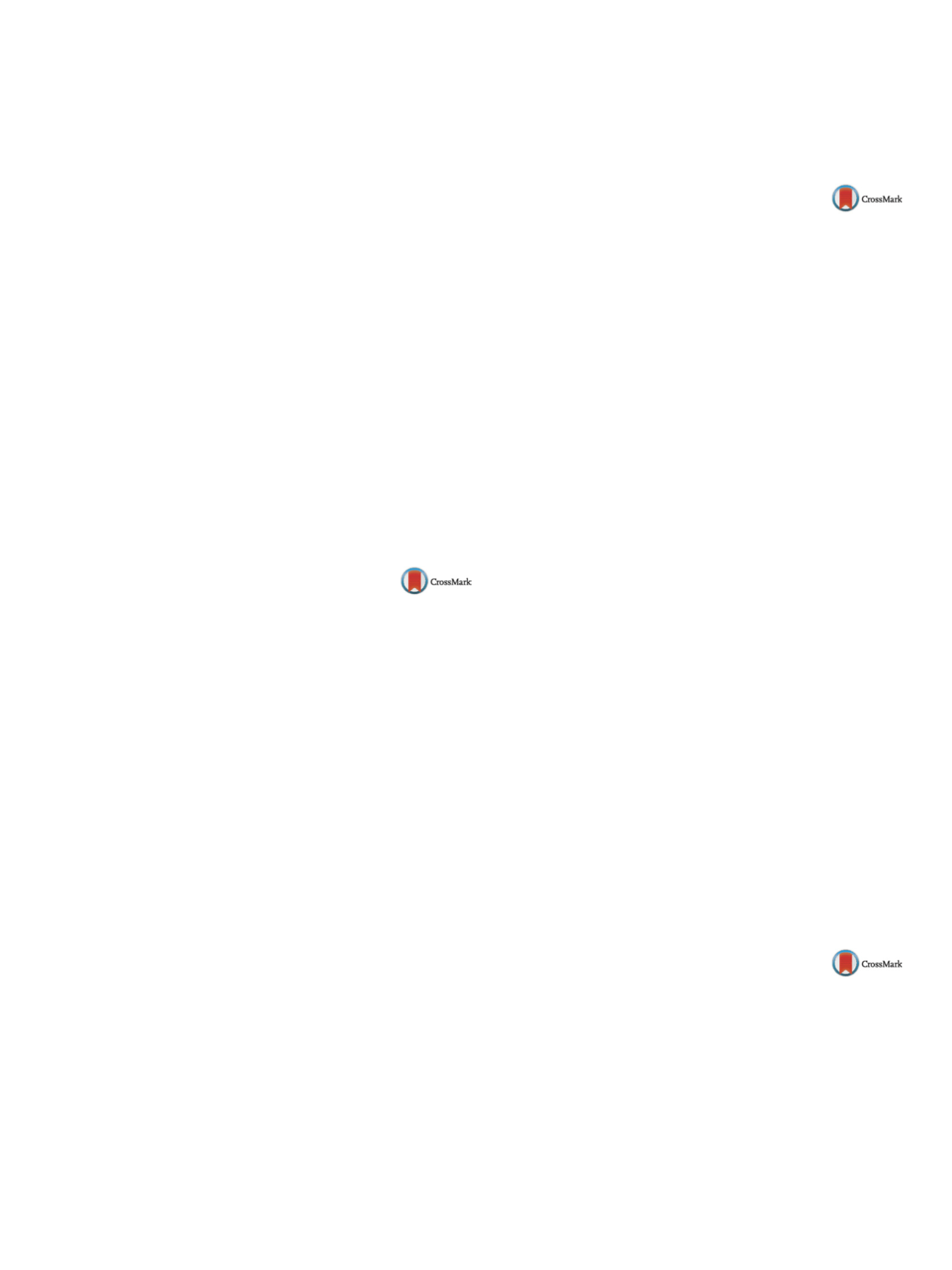

25th European Congress of Psychiatry / European Psychiatry 41S (2017) S106–S169
S145
tion and the extent to which psychiatric co-morbidity is taken into
account.
Aim
To determine, whether MDD should be considered an
episodic or chronic disorder.
Objective
To examine the 6 year course of MDD, incorporating
data of multiple time points and taking common psychiatric co-
morbidities into account.
Methods
Data were from903 patients with current MDD at base-
line in the Netherlands study of depression and anxiety, with
subsequent data from 2 year, 4 year and 6 year follow-up. Four
course trajectories were created taking all information during
follow-up into account classifying patients as (1) recovered, (2)
recurrent without chronic episodes, (3) recurrent with chronic
episodes or (4) consistently chronic. A chronic episode was defined
as having symptoms consistently over 2 years.
Results
The recovery rate of MDDwas 58% at 2 year follow-up but
looking at 6 year follow-up and taking into account co-morbid dys-
thymia, (hypo) mania and anxiety disorders reduced this recovery
rate to 17%. Moreover, more than half of the patients experienced
chronic episodes.
Conclusions
Longitudinal data of this psychiatric cohort study
showed that full recovery is the exception rather than the rule.
MDD follows a chronic course and, moreover, persons are prone
to switch to other psychiatric disorders.
Disclosure of interest
The authors have not supplied their decla-
ration of competing interest.
http://dx.doi.org/10.1016/j.eurpsy.2017.01.1986EW0118
Mirtazapine and trazodone efficacy on
major depressive disorder (MDD) is
moderated by patients’ age and sex:
A randomized, controlled trial
M. Vilibi´c
1 ,∗
, ˇ Z. ˇSurina Osmak
2 , M.Tomljenovi´c
3 , B. Kolari´c
4 ,V. Juki´c
51
University Psychiatric Hospital Vrapˇce, Department of Biological
Psychiatry and Psychogeriatrics, Zagreb, Croatia
2
Ministry of Defence of the Republic of Croatia, Department of
Health, Zagreb, Croatia
3
Medical School, University of Rijeka, Department of Social Medicine
and Epidemiology, Rijeka, Croatia
4
Andrija ˇStampar Teaching Institute of Public Health, Service for
Epidemiology, Zagreb, Croatia
5
University Psychiatric Hospital Vrapˇce, Department of Forensic
Psychiatry, Zagreb, Croatia
∗
Corresponding author.
Introduction
NaSSA antidepressant mirtazapine and SARI tra-
zodone has proven efficacy on MDD.
Aim
To compare differences in mirtazapine and trazodone effi-
cacy on MDD in different age and sex groups.
Methods
A consecutive sample of 60 MDD outpatients were ran-
domized to mirtazapine 30mg/day or trazodone 150mg/day for a
3months stable dosing period at the department of biological psy-
chiatry and psychogeriatrics of the university psychiatric hospital
Vrapˇce, Croatia. Outcome was relative lowering of HAMD-17 scale
result. The study was single blind: rater was blinded, while patients
informed regarding prescribed medication.
Results
Overall efficacy of mirtazapine and trazodone was com-
parable (84% lowering of HAMD–17 in both cases; difference
P
= 0.754). After adjustment for MDD baseline severity (CGI–S),
education, marital and working status, interaction of age and sex
significantly moderated two drugs’ efficacies. In patients older
than 47 years, in male patients trazodone was significantly more
effective, and in female patients significantly less effective than
mirtazapine. This effect was increasing by aging.
Conclusion
Mirtazapine and trazodone efficacy on MDD is mod-
erated by patients’ age and sex.
Disclosure of interest
The authors have not supplied their decla-
ration of competing interest.
http://dx.doi.org/10.1016/j.eurpsy.2017.01.1987EW0119
Early prediction of non-response to
anti-depressive treatment with an
easy-to-use electrophysiological index
dynamics
S. Yariv
1 ,∗
, G. Shahaf
2, B. Bloch
1, A. Reshef
1, Y. Bloch
31
Emek Medical Center, Psychiatry, Afula, Israel
2
BrainMARC, Chief Scientist, Yoqneam, Israel
3
Shalvata Mental Health Center, Child and Adolescent Outpatient
clinic, Hod Hasharon, Israel
∗
Corresponding author.
Introduction
The evaluation of response to pharmacological
treatment in MDD requires 6–8 weeks. Therefore, the ability
to predict response, and especially lack of response to treat-
ment, as early as possible after treatment onset or change, is of
major significance. Many studies demonstrated significant results
regarding the ability to use EEG and ERP markers. However,
these markers are derived from long EEG/ERP samples, often from
multiple channels, which render them impractical for frequent
sampling.
Methods
We developed a new electrophysiological attention-
related marker from a single channel (2 electrodes) and 1minute
samples. This work presents an initial evaluation of the ability to
harness this marker, for early differentiation between responders
and non-responders to anti-depressive treatment, in 26 patients
with various levels of depression and heterogeneous treatment
interventions and 10 healthy controls. Subjects who initiated
treatment for depression were followed clinically through their
Hamilton depression scores as well as their EEG activity twice
a week for a period of 8 weeks. Any acceptable anti-depressive
treatment been included. The improvement in Hamilton scores
at the end of 8 weeks used to discriminate responders and non-
responders.
Results
Within two weeks, we could differentiate between non-
responders and responders to anti-depressive treatment, with
absolute discrimination between subjects with moderate to severe
depression, andwith 0.71 sensitivity and 0.96 specificity within the
whole depressed subjects.
Conclusions
This is a proof of concept for an easy to use, cheap and
quick marker for the lack of respond to anti-depressive treatment
within two weeks of anti-depressive treatment.
Disclosure of interest
Relevant: BrainMARC ltd funded the study.
Non relevant: Lundbeck Israel- honorarium.
Unipharm ltd honorarium.
http://dx.doi.org/10.1016/j.eurpsy.2017.01.1988EW0120
The dopaminergic polymorphisms in
psychomotor retardation of
depression: A pathway-based imaging
genetics association study
Y. Yin
∗
, Y. Yuan
Affiliated ZhongDa Hospital and Institute of Neuropsychiatry of
Southeast Univer, Department of Psychosomatics and Psychiatry,
ZhongDa Hospital School of Medicine Southeast University, Nanjing,
China
∗
Corresponding author.
Introduction
Several lines of evidence implicate dopamine is
involved in the psychomotor retardation (PMR) in major depres-
sive disorder (MDD). Besides, abnormal cerebral blood flow (CBF) of
PMR was also found in the cortico-basal ganglia-thalamo-cortical


















